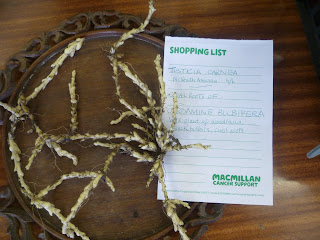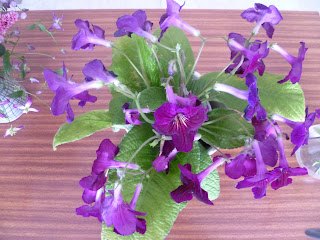Presentation: Thomas
Fairchild by Celia Latham Brown
Longstanding Friday Forum member Celia
Latham Brown kept the audience enthralled with a most interesting and
informative talk on the gardener and plant breeder Thomas Fairchild (1667 –
1729).
A farmer’s son from Wiltshire, Fairchild
became an apprentice cloth worker and after being introduced to gardening,
realised he preferred the outdoors. We
worked in Hoxton at a nursery and presently became its owner.
By transferring the pollen of a Carnation
to stigma of Sweet William, Fairchild created a new plant – the first hybrid
and known as Fairchild’s mule. As a keen
Christian, he did fear God’s wrath. He
corresponded with Carl Linnaeus and by experiments, established
the existence of sex in plants.
At that time, there was strong competition
amongst grand estate holders to have new and different plants, so his work was
very much in demand.
When Fairchild’s friend Blair presented his
paper to the Royal Society in 1716, there were outcries of blasphemy and that
it was morally dangerous, meddling with nature.
Later, another friend, Sir Hans Sloane of Sloane Square fame, presented
another of Fairchild’s papers on the Circulation of Sap
A member of the Society of Gardeners,
Fairchild’s aim was to produce a catalogue of new species of plants. In 1722 he published a small book The City
Gardener, detailing which plants would thrive best in London. This publication also advised that large plants
would benefit from being taken into the countryside and also that there should
be open spaces in towns and cities to provide fresh air for their residents.
Thomas Fairchild died at the age of
62. In his will he left a sum of £25.00 an annual sermon be given in celebration of Horticulture. This
still happens to this day on Whit
Tuesday at St Giles Church, Cricklegate, and has become known as the Vegetable
Sermon.
Celia’s talk was all the more
remarkable as all the research was from books (as opposed to the internet)
including The Ingenious Mr Fairchild: The Forgotten Father of the Flower
Garden (Faber Find) by Michael Leapman and a chapter in The Brother Gardeners: Botany, Empire and the Birth of an
Obsession (2009) by Andrea Wulf
We
look forward to Celia’s next talk
Display
Table
Gerry explained that the original reason
for a Display Table at gardening groups was that it was the only way for
gardeners to continue their education in horticulture. Traditionally, this took place on a Saturday
night and some gardeners would bring plants and demonstrate their skills to
others.
 |
Carol ‘s Echiveria Painted Lady
|

Carol’s Erodium Spanish Eyes which has flowered all year
 |
|
Margaret M’s colourful posy of Dahlias
|

From her garden Gill brought yellow and
orange Begonias, Japanese Anemone, Phlox, Liriope, Chelone, Michaelmas Daisy, the
yellow Kirengeshoma, Crocosmia and the toad lily Tricyrtis. Make a note if you want to extend the season
 |
| Ann’s Justicia Carnea comes from the Acanthus family and comes from the North of South America. It has been out all summer but will be overwintered in a frost free spot. |
 |
| Ann has dug up (hopefully all) the coral roots of the invasive, wild woodland plant of Cardamine bulbifera which spreads by the small black bulbils it produces. |
Gardening
Matters
Do you know about this mysterious female
gardener who got no public recognition during her lifetime?
Notice
Board
Thanks to those who helped organise and sponsored
the recent and improvements to Paxton Hall; repairs to the roof, broken window
and outside light and the decoration of the exterior and the main hall.
Upcoming meetings:
Next meeting is 5th October
(see details below) but we wanted to give you early notice of the two meetings
which follow.
19th October: This is our Harvest Forum and Bring & Buy sale. This year we are going for a Brexit Bash and will be asking members to sign up to bring a typical food or drink from an EU country.
Friday 2nd November: A celebratation for the 50th anniversary of the Society
moving into our current premises. More details TBA.
Next
Meeting
5th October: Presentation by Ken Matthewman – Kew through
the seasons





















